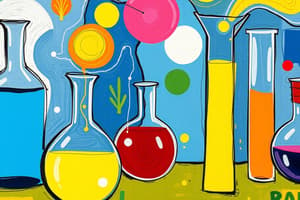Podcast
Questions and Answers
What are the three main sources of environmental contaminants in food?
What are the three main sources of environmental contaminants in food?
Air, water, and soil
What are natural toxicants in foods?
What are natural toxicants in foods?
Substances that occur naturally in certain foods and have the potential to be toxic to humans.
How do environmental contaminants find their way into our bodies?
How do environmental contaminants find their way into our bodies?
Through consumption of contaminated plants, meat, milk products, fish, and other seafood.
What is the harm of environmental contaminants dependent on?
What is the harm of environmental contaminants dependent on?
Define contaminants in the context of food.
Define contaminants in the context of food.
Why is there growing concern about environmental contamination of foods?
Why is there growing concern about environmental contamination of foods?
What are short-lived contaminants in the environment broken down by?
What are short-lived contaminants in the environment broken down by?
What is the process known as when contaminants resist breakdown and accumulate in each level of the food chain?
What is the process known as when contaminants resist breakdown and accumulate in each level of the food chain?
How did acute contamination of Methylmercury occur in Minamata, Japan in 1953?
How did acute contamination of Methylmercury occur in Minamata, Japan in 1953?
What caused the acute contamination of PBB (Polybrominated Biphenyls) in Michigan in 1973?
What caused the acute contamination of PBB (Polybrominated Biphenyls) in Michigan in 1973?
What were the health effects observed in individuals exposed to PBB in Michigan in 1973?
What were the health effects observed in individuals exposed to PBB in Michigan in 1973?
What was the source of PCB (Polychlorinated Biphenyls) contamination in Japan in 1968 and Taiwan in 1979?
What was the source of PCB (Polychlorinated Biphenyls) contamination in Japan in 1968 and Taiwan in 1979?
What were the effects seen in children born to women who had eaten the tainted rice oil containing PCB?
What were the effects seen in children born to women who had eaten the tainted rice oil containing PCB?
In what ways can contaminants enter the environment?
In what ways can contaminants enter the environment?
What is the sequence in which living things depend on other living things for food called?
What is the sequence in which living things depend on other living things for food called?
What is the fate of short-timed contaminants in the body?
What is the fate of short-timed contaminants in the body?
Study Notes
Environmental Contaminants in Food
- Sources:
- Agriculture: pesticides, fertilizers, animal waste
- Industrial activity: emissions, waste disposal, manufacturing processes
- Natural sources: toxins produced by plants and animals
Natural Toxicants in Foods
- Examples of natural toxicants:
- Solanine in potatoes
- Cyanogenic glycosides in almonds
- Aflatoxins (produced by fungi)
How Contaminants Find Their Way into Our Bodies
- Through food, water, or air
- Bioaccumulation: contaminants become more concentrated in organisms higher up the food chain
- Biomagnification: the process of increasing concentration of contaminants in organisms at higher trophic levels in the food chain
Factors Affecting Harm of Environmental Contaminants
- Concentration: higher levels of contaminants pose a greater threat
- Duration of exposure: prolonged exposure increases the risk of health issues
- Individual susceptibility: factors like age, health conditions, and genetics can influence vulnerability
Contaminants in the Context of Food
- Undesirable substances found in food that were not intentionally added
- Can be biological (bacteria, viruses), chemical (pesticides, heavy metals), or physical (glass, plastic)
Growing Concern Over Contamination
- Globalized food system: the transport of food across national borders increases the risk of contamination
- Increased industrial activity: more factories and industrial practices lead to greater potential for pollution
- Climate change: extreme weather events can disrupt food production and increase the risk of contamination
Fate of Short-Lived Contaminants
- Breakdown: quickly degraded by environmental factors like sunlight, air, and water
Bioaccumulation of Persistent Contaminants
- Resistance to breakdown: remain in the environment for extended periods
- Accumulation: build up in organisms over time, becoming more concentrated at each level of the food chain
Minamata Disease: Methylmercury
- 1953: Massive contamination of Minamata Bay, Japan, by methylmercury released from a chemical factory
- Effects: Severe neurological damage, birth defects, and death
PBB Contamination in Michigan
- 1973: Accidental contamination of livestock feed with polybrominated biphenyls (PBB)
- Source: Commercial chemical company
- Effects: Liver damage, skin problems, reproductive issues
PCB Contamination in Japan and Taiwan
- 1968 (Japan) and 1979 (Taiwan): Contamination of rice oil with polychlorinated biphenyls (PCB)
- Source: Industrial chemicals used in the production process
- Effects: Skin problems, liver damage, developmental delays in children exposed in utero
Pathways for Contaminants to Enter the Environment
- Industrial discharges: manufacturing waste, emissions
- Agricultural practices: pesticides, fertilizers, animal waste
- Waste disposal: landfills, sewage treatment plants
Food Chain and Contaminants
- Food chain: sequence of organisms in which each organism consumes the one before it
- Biomagnification: contaminants accumulate at higher levels in the food chain, posing greater risk to predators
Fate of Short-Lived Contaminants in the Body
- Elimination: excreted by the body through various processes, such as urine and feces
Studying That Suits You
Use AI to generate personalized quizzes and flashcards to suit your learning preferences.
Description
Learn about environmental contaminants, natural toxicants in foods, and indirect or incidental additives with Dr. Lim See Meng, Senior Lecturer at the Nutritional Sciences Programme Centre for Community Health Studies.




